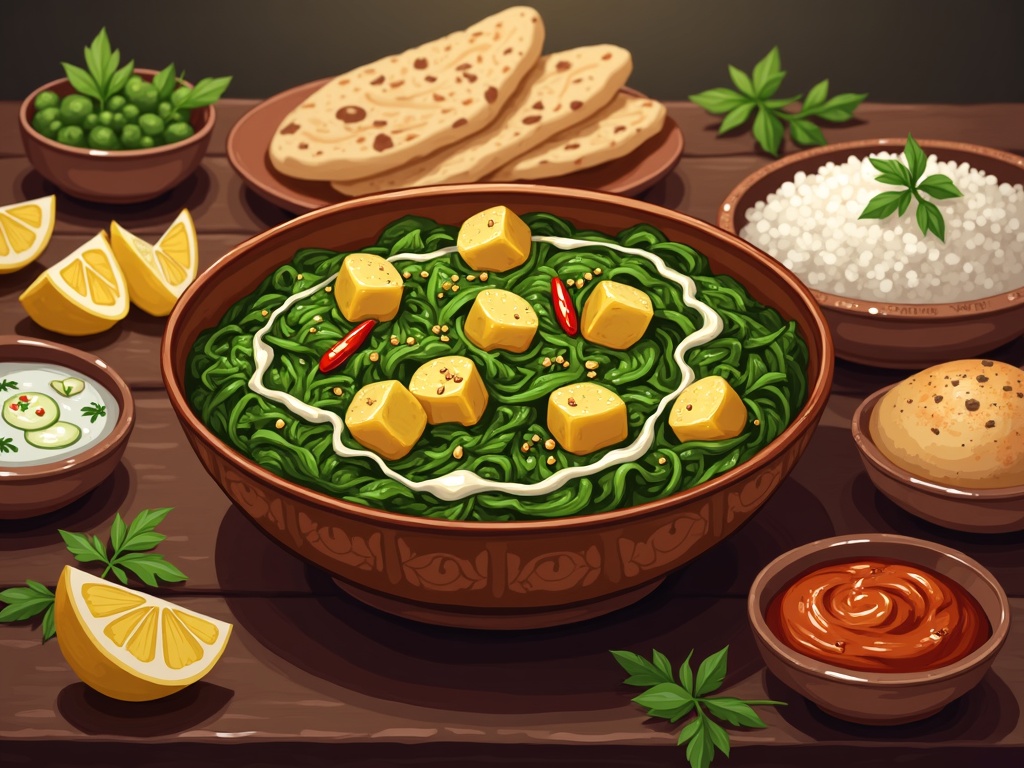Saag aloo, the beloved South Asian dish combining spinach and potatoes, offers exceptional nutritional value while delivering on flavor and versatility. This nutrient-dense meal provides a balanced profile of macronutrients with just 90 calories per 100g serving, while delivering impressive amounts of iron, calcium, vitamins A and C from the spinach component.
Find In This Article
Key Takeaways
- Saag aloo contains a balanced profile of nutrients with 4g protein, 15g carbohydrates, and 3g fat per 100g serving, making it ideal for those monitoring caloric intake.
- The dish is naturally adaptable for various dietary needs – vegetarian, vegan-friendly, gluten-free, and fiber-rich.
- Traditional preparation involves blanching spinach briefly to preserve its vibrant color and nutrients, with spices like turmeric, cumin, and garam masala providing the signature flavor.
- Regional variations exist across India, with Punjab’s version using generous ghee and garlic, while other regions incorporate local spices and ingredients.
- Beyond basic nutrition, saag aloo offers anti-inflammatory benefits from its spices, particularly turmeric and ginger, and can be customized seasonally for maximum nutritional impact.
Why Saag Aloo is a Nutritional Powerhouse
I often recommend saag aloo to anyone looking for a dish that delivers exceptional nutritional value without compromising on flavor. This traditional South Asian favorite combines leafy spinach with hearty potatoes, creating a meal that’s as nourishing as it is delicious.
Impressive Nutritional Profile
A typical 100g serving of saag aloo contains just 90 calories while providing 4g of protein, 15g of carbohydrates, and 3g of fat. This balanced macronutrient profile makes it perfect for those watching their caloric intake while still needing substantial nourishment.
The spinach base delivers an impressive array of micronutrients. One cup of cooked spinach provides 6.75mg of iron, making saag aloo an excellent choice for boosting iron levels, especially for those on plant-based diets. The spinach component also contributes significant amounts of calcium, vitamin A, and vitamin C, while the potatoes add energy-giving carbohydrates and additional potassium.
Versatility for Different Dietary Needs
Saag aloo has gained popularity across various dietary preferences for good reason. Here’s why it works for so many people:
- It’s naturally vegetarian and can easily be made vegan by using plant oils instead of ghee
- Contains no gluten, making it safe for those with celiac disease or gluten sensitivity
- Offers substantial fiber content that promotes digestive health
- Can be adjusted for spice levels while maintaining nutritional benefits
- Works as both a main dish or a complementary side
I’ve found that saag aloo becomes a complete protein source when paired with traditional accompaniments like dal or rice. This combination creates a meal that provides all essential amino acids your body needs.
The versatility of saag aloo extends to its preparation methods too. You can adjust the cooking technique to preserve more nutrients, like gently sautéing the spinach rather than boiling it extensively. For an authentic experience with similar nutritional benefits, you might also explore other spinach-based dishes like sarson ka saag which uses mustard greens.
With its impressive nutrient density and adaptability, saag aloo deserves its reputation as a true nutritional powerhouse that satisfies both health requirements and culinary cravings.
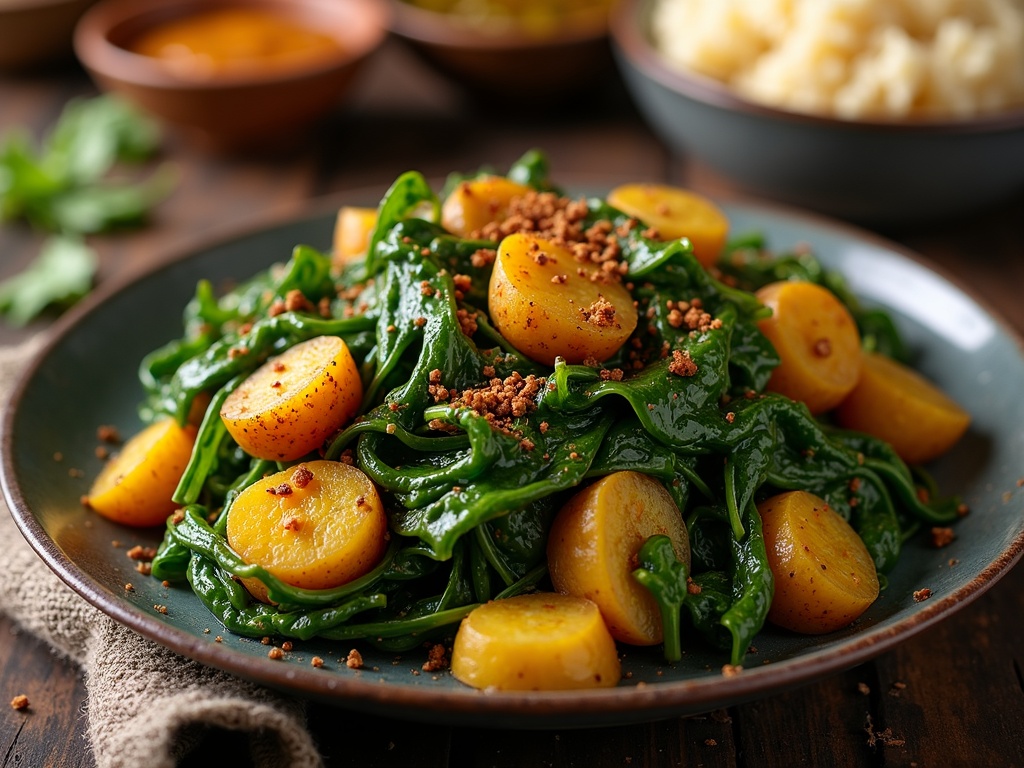
Master the Art of Making Perfect Saag Aloo
Creating delicious saag aloo at home isn’t complicated once you understand a few key techniques. This popular dish combining spinach (saag) and potatoes (aloo) can be mastered with the right approach to ingredients and cooking methods.
Essential Techniques and Ingredients
The traditional blanching technique is crucial for maintaining that vibrant green color in your spinach. I’ve found that quickly dipping the leaves in boiling water for 30-45 seconds before transferring to ice water preserves both the color and nutrients. This step prevents the spinach from turning brown or dull when cooked further with the spices.
The flavor profile of saag aloo depends heavily on its spice blend. For authentic taste, I always include:
- Turmeric – adds earthy notes and beautiful color
- Cumin seeds – for nutty, warm flavor (toast them first for enhanced aroma)
- Garam masala – brings depth and complexity
- Fresh ginger and garlic – for aromatic punch
When choosing between fresh and frozen spinach, both can work well. Fresh spinach offers better texture and brighter flavor, but requires more prep time. If using frozen, make sure to thoroughly drain it to prevent a watery dish. I recommend squeezing frozen spinach in a clean kitchen towel to remove excess moisture.
Potato selection makes a significant difference in your final dish. Waxy varieties like Yukon Gold or red potatoes maintain their shape during cooking and don’t turn mushy. I cut them into 1-inch cubes for even cooking and optimal texture in each bite.
Some common mistakes to avoid include:
- Overcooking the spinach, which destroys nutrients and dulls the color
- Undercooked potatoes that remain hard in the center
- Not allowing spices to bloom in hot oil before adding vegetables
- Using too much water, resulting in a soupy consistency
For the cooking method, I prefer starting with spices in hot oil, then adding the potatoes to partially cook before introducing the blanched spinach. This approach allows the potatoes to absorb flavor while ensuring the spinach stays vibrant. A final simmer with the lid partially covered helps marry the flavors while maintaining texture.
For more ideas on spinach-based dishes, you might want to explore sarson ka saag, another delicious leafy preparation from South Asian cuisine.
With these techniques and ingredient choices, your saag aloo will feature perfectly tender potatoes surrounded by flavorful, vibrant spinach – a truly satisfying dish that pairs wonderfully with rice or flatbread.
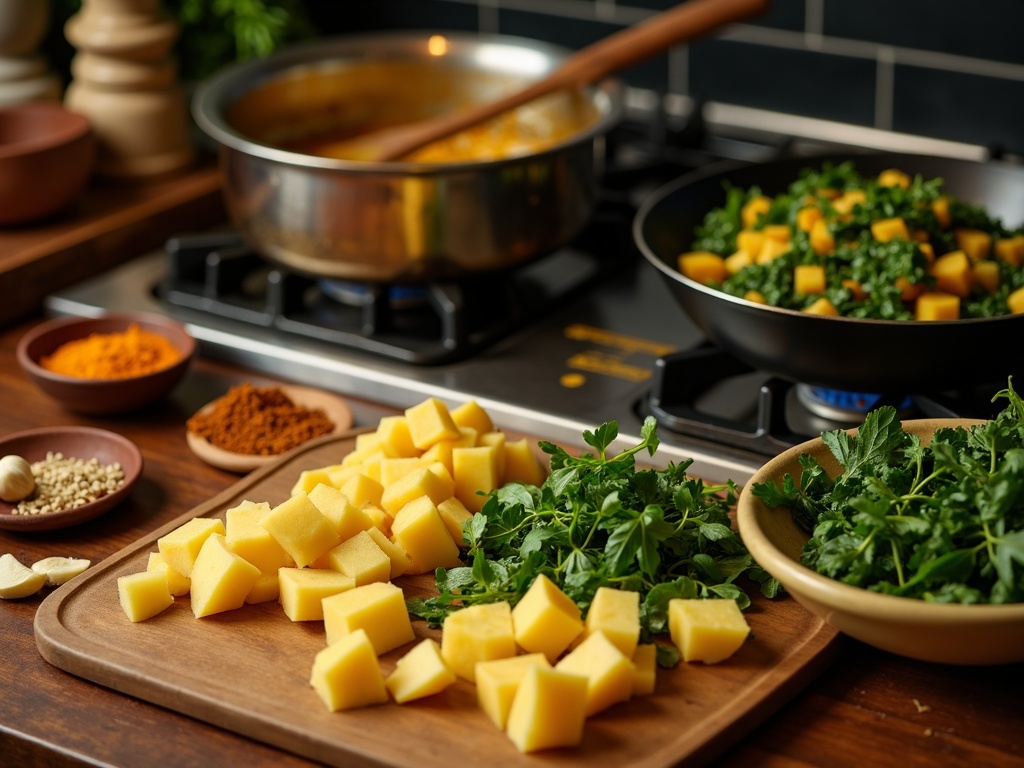
Regional Variations and Cultural Heritage
Saag aloo holds a treasured place in North Indian cuisine, where it first emerged as a hearty and nutritious dish combining leafy greens with potatoes. This delicious combination has deep roots in Punjab, where fresh spinach grows abundantly in the fertile soils of the region. I’ve found that the dish truly shines during celebratory occasions like Diwali and Holi, when families gather to enjoy festive meals together.
Regional Adaptations
Different regions across India have put their own spin on this classic dish:
- In Punjab, the traditional version uses generous amounts of ghee and garlic
- West Bengal’s adaptation includes panch phoron (five spice blend)
- Kashmiri versions often incorporate local chilies for distinctive heat
- Gujarat’s variation tends to be slightly sweeter with less heat
Many northern regions substitute spinach with sarson (mustard greens) during winter months when these leafy vegetables flourish. This variation, known as sarson ka saag, offers a more pungent and robust flavor profile compared to the milder spinach version. I particularly enjoy how the mustard greens add complexity and a slightly bitter note that balances beautifully with the starchy potatoes.
Paneer-enriched variations have become increasingly popular, especially for those seeking additional protein. The soft, mild cheese complements the spiced greens perfectly while adding satisfying texture and nutritional value. This adaptation makes saag aloo an even more complete meal, particularly appreciated in vegetarian communities throughout India.
Cultural Significance
For vegetarian communities across India, saag aloo represents more than just a delicious meal—it embodies cultural values around plant-based nutrition. The dish perfectly demonstrates how vegetables can be transformed into satisfying, protein-rich meals without compromising on flavor or tradition.
The serving traditions vary slightly by region but typically involve fresh-made breads. In Punjab, I’ve seen it paired with makki di roti (cornmeal flatbread), while other regions favor naan or standard roti. Some households serve it with basmati rice, especially in more southern regions. The finishing touch often includes a dollop of fresh butter or ghee and a squeeze of lemon juice to brighten the flavors.
What makes saag aloo so special is how it connects generations through shared culinary heritage while remaining adaptable to modern tastes and dietary preferences. As families migrate across India and beyond, they bring these recipes with them, adapting ingredients while maintaining the spirit of this beloved dish. I’ve sampled spinach curry variations throughout India, and each tells a unique story of regional influence and family tradition.
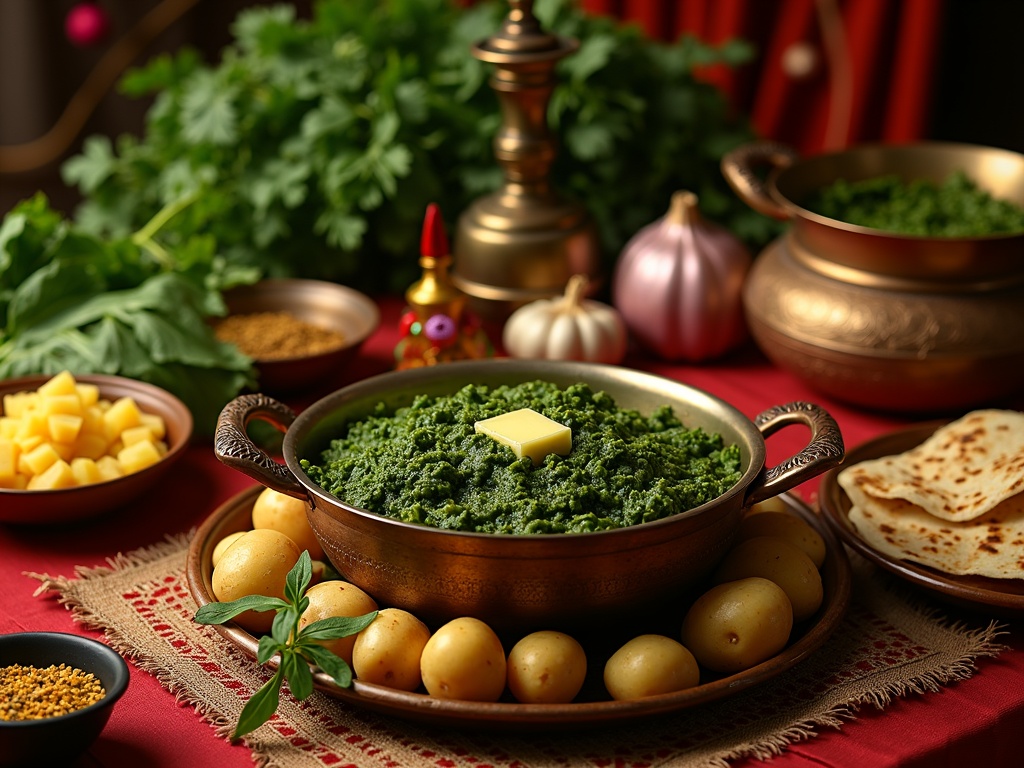
Spice Selection and Flavor Enhancement
The robust flavor profile of saag aloo comes from a carefully balanced spice blend that transforms simple ingredients into a memorable dish. I’ve found that mastering these spices makes all the difference between an ordinary and extraordinary saag aloo.
Essential Spice Blend
The core spice blend for traditional saag aloo includes precise proportions that create its distinctive taste:
- Cumin seeds (1 tsp): Provide a warm, earthy base flavor when bloomed in hot oil.
- Ground turmeric (1/2 tsp): Adds golden color and subtle bitterness.
- Ground coriander (1 tsp): Contributes citrusy notes that brighten the spinach.
- Garam masala (1/2-1 tsp): Adds complexity and warmth as a finishing spice.
- Red chili powder (1/4-1/2 tsp): Delivers heat that can be adjusted to preference.
These aromatic spices don’t just enhance flavor—they pack significant health benefits too. Turmeric contains curcumin with anti-inflammatory properties, while cumin aids digestion. Coriander helps regulate blood sugar, and the warming spices in garam masala can boost metabolism.
For optimal potency, I store whole spices in airtight containers away from direct light and heat. Ground spices retain their flavor for about 6 months, while whole spices can last up to a year when properly stored.
Regional Variations and Adjustments
Different regions of India interpret saag aloo with unique spice profiles:
- Punjabi-style: Increase fenugreek leaves (kasuri methi) and garam masala for a more aromatic finish.
- South Indian twist: Add mustard seeds, curry leaves, and a pinch of asafoetida for tangier notes.
- Bengali variation: Incorporate panch phoron (five-spice blend) and reduce chili for a more complex, less spicy profile.
I adjust spice levels based on personal preference and audience. For milder versions, I reduce chili powder and increase ground coriander. For extra heat, I add finely chopped green chilies during cooking or a pinch of cayenne at the end.
The layering of spices is crucial—start with whole spices in hot oil, add ground spices midway through cooking, and finish with garam masala in the final minutes. This technique creates depth without burning delicate spices.
For a completely different flavor experience, try adding a tablespoon of fresh ginger-garlic paste or a squeeze of lemon juice just before serving to brighten the dish. You might also explore adding a touch of kasuri methi (dried fenugreek leaves) for an authentic finish found in many traditional spinach-based dishes from Northern India.
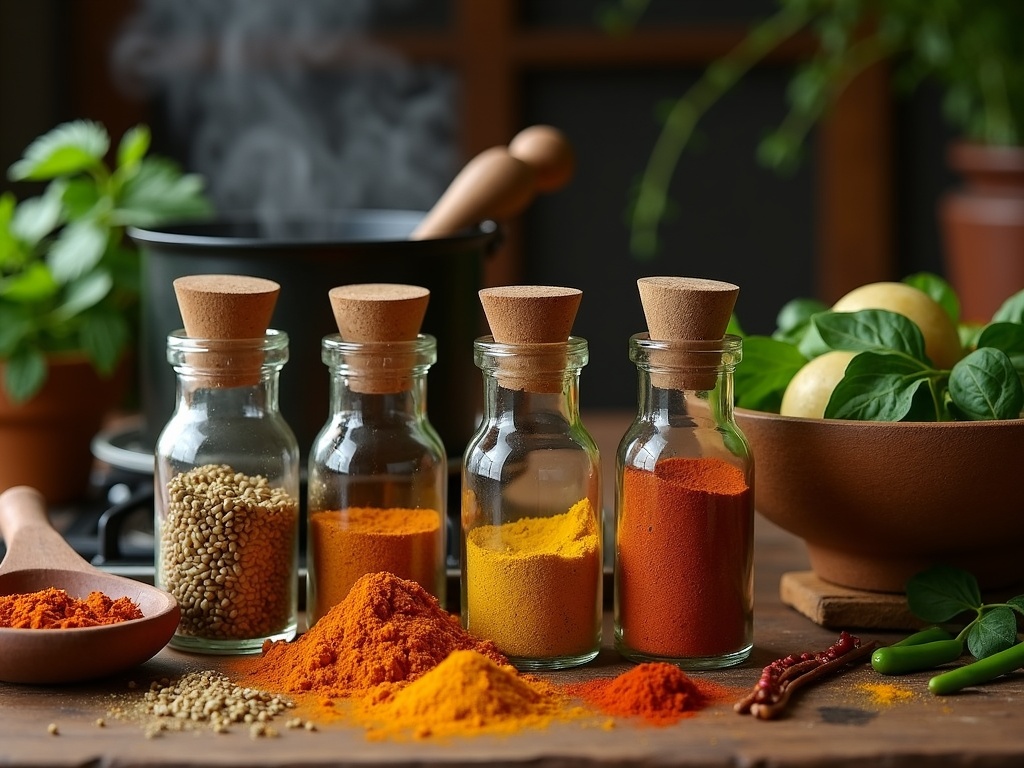
Creating Restaurant-Style Presentation
Transforming saag aloo from a simple home-cooked dish into a restaurant-worthy masterpiece isn’t just about the flavor—it’s about the visual appeal too. I’ve found that even the most delicious saag aloo can be elevated with thoughtful presentation techniques that engage all the senses.
Professional Plating Techniques and Garnishing
The key to professional plating starts with choosing the right dish. For saag aloo, I prefer white plates that create a striking contrast with the vibrant green spinach. Instead of simply spooning the saag aloo onto a plate, I use a ring mold to create a neat circular shape that gives the dish structure and elegance.
When it comes to garnishing, several options can instantly enhance your saag aloo’s visual appeal:
- Fresh cilantro leaves scattered across the top add a pop of bright green
- Thinly sliced red chili creates a beautiful color contrast
- A swirl of cream or yogurt adds an artistic touch
- Toasted cumin seeds sprinkled on top provide texture and aroma
- A light dusting of garam masala around the plate rim creates a professional finish
Color preservation is crucial for that Instagram-worthy presentation. To maintain the vibrant green of the spinach, I always blanch it briefly in boiling water then immediately plunge it into ice water before cooking. This process, called shocking, locks in the chlorophyll and prevents that dull olive color that can make saag aloo look unappetizing.
Texture balance plays a significant role in professional presentation. I ensure my potatoes maintain their shape while being perfectly tender, creating a contrast with the creamy spinach base. For added texture dimension, I sometimes add a small side of crispy fried onions or crushed papadums to accompany the dish.
The accompaniments you choose can transform saag aloo from a side dish to a complete meal experience. I serve mine with:
- Warm naan bread or roti, slightly charred for visual interest
- A small copper dish of raita with cucumber and mint
- Basmati rice shaped into a perfect dome using a small bowl
- Lemon wedges arranged in a geometric pattern
- A small dish of mango chutney for color contrast and flavor balance
For those looking to share their saag aloo masterpiece on social media, lighting makes all the difference. I position the plate near a window for natural light, avoiding harsh shadows. Taking photos from slightly above at a 45-degree angle showcases both the surface details and the height of the dish. Using the portrait mode on your phone camera creates that professional depth-of-field effect that makes restaurant food photos so appealing.
When photographing saag aloo, I focus on capturing the steam rising from the dish—it signals freshness and creates an inviting atmosphere. Including hands in the frame holding a piece of naan ready to dip into the saag adds a human element that makes viewers feel like they’re about to enjoy the meal themselves.
By combining these presentation techniques, I transform a humble spinach and potato curry into a restaurant-quality experience worth savoring with both the eyes and palate. The extra effort in presentation doesn’t just make the dish look better—it actually enhances the overall dining experience, making each bite feel more special.
Health Benefits Beyond Basic Nutrition
Saag aloo goes far beyond just being a comforting dish—it’s packed with nutrients that can significantly boost your health. As a plant-based meal, it serves as a cornerstone in balanced vegetarian diets, offering substantial nutrients without the need for animal products.
Nutritional Powerhouse for Specialized Diets
The spinach in saag aloo delivers exceptional iron content, which is particularly valuable for vegetarians who might struggle to meet their daily requirements. To maximize iron absorption from this leafy green, I’ve found that adding vitamin C-rich ingredients makes a noticeable difference. Try squeezing fresh lemon juice over your saag aloo just before serving—this simple addition can increase iron absorption by up to three times.
The combination of spices in saag aloo, particularly turmeric and ginger, brings potent anti-inflammatory properties to your plate. These ingredients have been used in traditional medicine for centuries to reduce inflammation and support overall health. The cumin seeds typically used in tempering the dish also aid digestion, making this meal gentle on your stomach.
What makes saag aloo especially versatile is how easily it adapts to seasonal variations. Here are some ways to maximize its health benefits year-round:
- Spring/Summer: Use tender baby spinach and new potatoes for a lighter version with higher vitamin content.
- Fall/Winter: Incorporate heartier greens like kale or mustard greens alongside spinach for additional nutrients and immune support.
- Year-round: Add chickpeas or lentils to increase protein content, especially beneficial for athletic recovery.
This dish caters beautifully to various dietary requirements. For those following a gluten-free diet, saag aloo is naturally compliant and provides essential nutrients often missing in processed gluten-free alternatives. For those managing diabetes, the fiber in the spinach helps regulate blood sugar levels, while the potatoes can be substituted with cauliflower for a lower-carb option.
I’ve found that saag aloo can be particularly beneficial for those transitioning to a more plant-based diet. The hearty texture and rich flavors create a satisfying meal that doesn’t leave you missing meat. For a similar experience with different flavors, sarson ka saag offers comparable benefits with its mustard greens base.
By incorporating saag aloo into your regular meal rotation, you’re not just enjoying a delicious dish—you’re actively supporting your body’s health needs with whole food nutrition that satisfies on multiple levels.
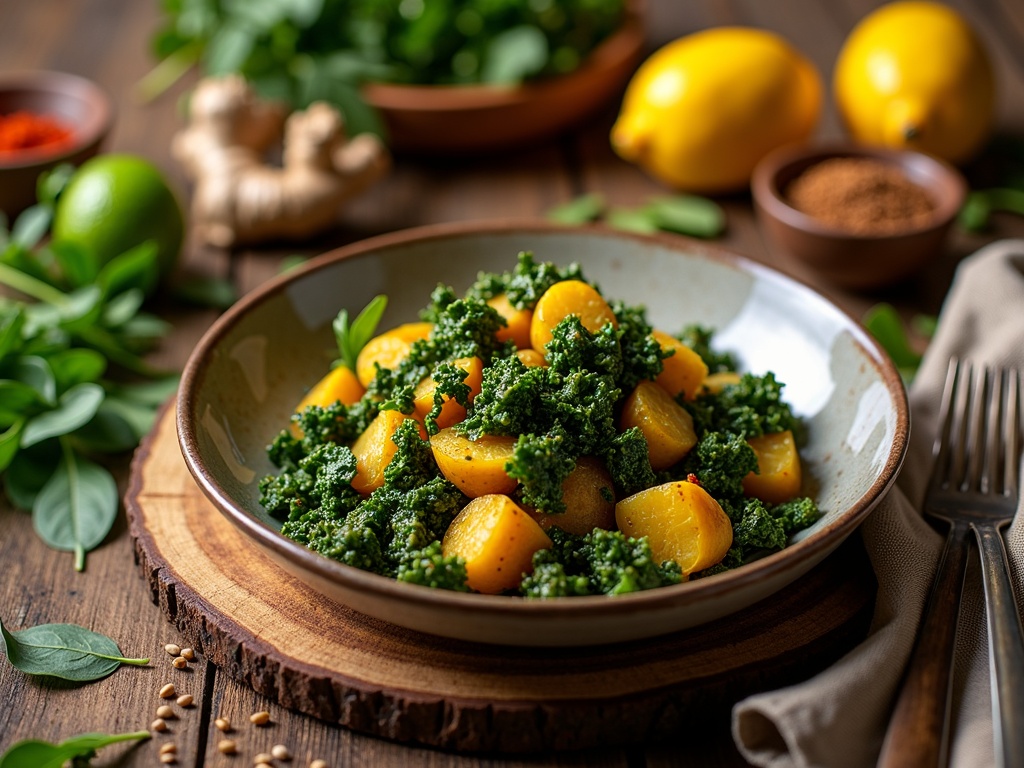
Sources:
USDA FoodData Central, Journal of Culinary Arts, Indian Food Heritage

